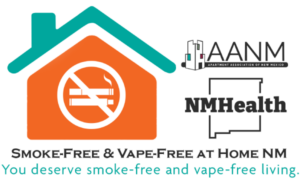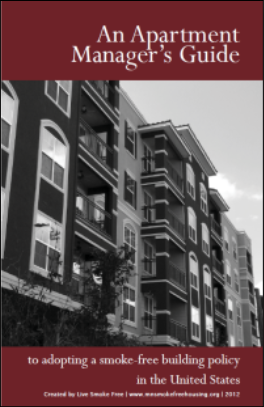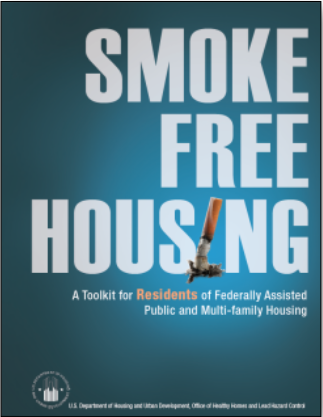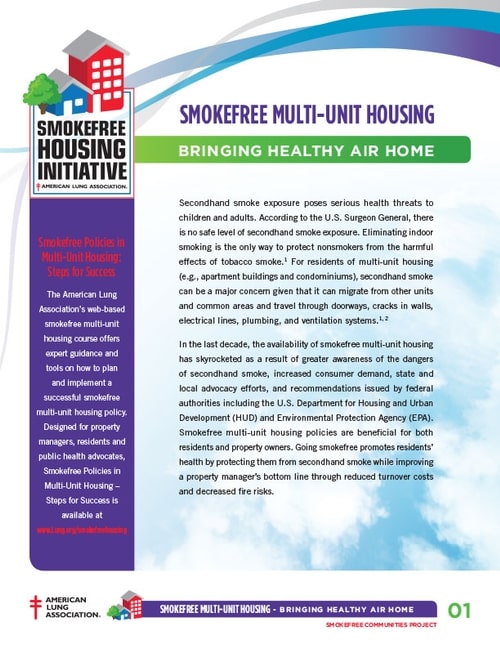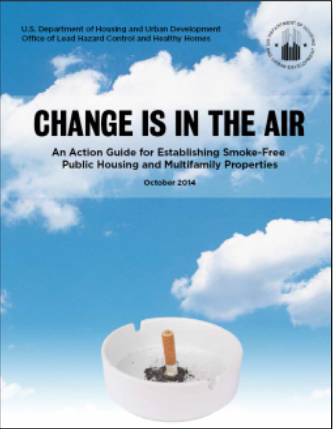Property Owners and Managers
SMOKE-FREE AND VAPE-FREE POLICIES WORK.
Several studies have reviewed whether residents support smoke-free/vape-free policies in multi-unit housing. Generally, former smokers, non-smokers, ethnic minorities, and those living with children support these policies specifically for improved health, fire safety, and building cleanliness.
Smoke-free and vape-free apartment buildings also maintain higher resale values. As the number of public places in which a person can smoke has shrunk, so has the number of homebuyers who are even willing to consider a home that has been smoked in.
What We Do For You
The Apartment Association of New Mexico (AANM), in partnership with the New Mexico Department of Health, will assist you in converting part or all of your multi-unit housing property into a smoke-free environment through our Smoke-Free at Home initiative.
We will provide technical support and assistance during the contemplation, research, and implementation phases. We will offer additional support in the following ways:
Education Manager and staff training, implementation presentations, on-site resident events, resident education, our signature “Thinking About Quitting” workshops, free marketing on our Smoke-Free Rental Property Map, social media, and more.
Get Your Properties Listed on Our Smoke-Free Property Map!
Reduce Turnover Costs
Units that have been smoked in are considerably more expensive to turn over for the next resident than nonsmoking units, and smoking units also tend to remain on the market longer. The costs related to cleaning and renovation are up to 75% lower in smoke-free properties. Units that housed smoking tenants incur additional expenses to clean, repaint walls, and replace carpets, flooring, countertops, drapes, and fixtures damaged by cigarette burns or smoke exposure. Research shows that it is impossible to prevent smoke from infiltrating between apartments. One cannot escape the impact of neighboring units that contain cigarette smoke. The average cost for sealing a unit is about $700, which does not eliminate the problem. There is no safe amount of secondhand smoke; being around it briefly can cause harm. Children, pregnant women, older people, and people with heart or breathing problems are especially vulnerable.
Adopting smoke-free multi-unit housing policies can save property managers and owners hundreds and thousands of dollars in building maintenance and turnover costs. Insurance companies often provide premium discounts to properties that implement smoke-free policies.

Lower Fire Risks and Related Insurance Costs
Smoking-related fires are the leading cause of fire deaths, and account for 17 percent of fire deaths in residential buildings and $303 million in property loss each year. There are 1,000 smoking-related fires in the United States every year resulting in between 700 and 900 deaths. Smoke-free policies reduce fire risks for residents, owners, and property managers. In some states, multi-unit property managers/owners, and condominium associations with smoke-free policies are eligible for discounts on fire, life, and property insurance.
- Ask if your current policy has a penalty (explicit or hidden) if your building is not smoke-free. Some insurers add a “debit” to the premium unless they are shown that leases for the apartment building require all units to be smoke-free.
- Make an insurance premium credit a priority for discussion and negotiation with your insurer. In recent years, many insurers have dropped many “premium perks” due to unrelated losses in the insurance business.
Financial Incentives
Some states offer financial incentives to real estate developers that adopt smoke-free housing policies. In California, for example, 38 out of 74 public housing authorities have received tax credits for making their units smoke-free. Additionally, cities and states, including California, Maine, Minnesota, and New Hampshire, use the Low-Income Housing Tax Credit program to encourage developers to include smoke-free policies in new building projects. 11 For New Mexico, the Mortgage Finance Authority’s Low-Income Housing Tax Credit program incentivizes the implementation of a smoke-free policy on both new and rehabilitated properties. For more information, go to http://www.housingnm.org.
Legal Compliance
Many property owners and managers are unaware that smoke-free policies are legal and enforceable. The U.S. Department of Housing and Urban Development (HUD) supports property owners with smoking restrictions in their leases for federally subsidized housing. Recently, HUD passed a law requiring all PHAs to have a smoke-free policy by June 30, 2018. Being a smoker is not protected under civil rights laws.
F.A.Q.'s
Q. Is it legal for me to ban smoking and vaping in my apartment or condominium?
A. Yes. It is legal for apartment owners or condominium associations to adopt a smoke-free/vape-free policy for their units and buildings.
Q. Does this mean that smokers or those who vape can’t live in my building?
A. No. Smoke-free and vape-free policies restrict smoking and vaping – not smokers and those who vape. A smoke-free/vape-free policy does not limit who can live in an apartment or condominium so long as all residents and their guests refrain from smoking or vaping within that community’s policy. (View Certified Property page for certification level descriptions).
Q. Is a smoke-free /vape-free rule discriminatory?
A smoke-free/vape-free policy is not discriminatory. Smoking/vaping is a behavior, not an inborn characteristic, like race or sex, so prohibiting smoking or vaping does not target any particular group. Also, a smoke-free/vape-free rule doesn’t mean you can’t rent to smokers or those who vape; they have to smoke or vape with respect to the policy adopted for that community.
Q. Don’t smokers and those who vape have a right to smoke in their own homes?
No. No “right to smoke/vape” provision exists under federal, state, or local laws. Smokers and those who vape are not a protected class. You own the building. It is your property, and you have the right to set reasonable rules that protect it.
Q. Is secondhand smoke/ vape aerosols really that dangerous?
A. Yes. There are more than 7,000 chemicals have been identified in secondhand tobacco smoke. At least 69 of these chemicals are known to cause cancer, including arsenic, benzene, beryllium, chromium, and formaldehyde. Vape aerosol is made up of a high concentration of ultrafine particles, and the particle concentration is higher than in conventional tobacco cigarette smoke.
Tools & Resources
Additional Resources
Websites
Spanish Resources
References
- Smoke-Free Housing New York (2010) “Steps to Smoke-Free Housing NY”
- Wilder Research (2009) “Perceptions of Secondhand Tobacco Smoke Among Minnesota Area Renters”
- Smoke-Free Oregon, smokefreeoregon.com
- NM Department of Health (2012) “Tobacco Use Prevention and Control Fact Sheet”
- Association for Nonsmokers-Minnesota (2009) “An Apartment Manager’s Guide to Adopting a Smoke-Free Building Policy”
- U.S. Fire Administration website. usfa.fema.gov
- U.S. Fire Administration (2005) “Residential Smoking Fires and Causalities”
- U.S. Fire Administration (2012) “Smoking-Related Fires in Residential Buildings (2008-2010)”
- Center for Energy and Environment (2004) “Reduction of Environmental Tobacco Smoke Transfer in Minnesota Multifamily Buildings Using Air Sealing and Ventilation Treatments”
- Center for Energy and Environment (2004) “Reduction of Environmental Tobacco Smoke Transfer in Minnesota Multifamily Buildings Using Air Sealing and Ventilation Treatments”
- Oregon Public Health Division, Health Promotion and Chronic Disease Prevention and Program Design and Evaluation Services. Evaluation of the Implementation of a Smoke-Free Policy in Subsidized Multi-Unit Housing. March 2009.
- Matt, G et al. When smokers move out and non-smokers move inL residential thirdhand smoke pollution and exposure. Tobacco Control 2011;20
- Tobacco Control Legal Consortium. Regulating Smoking in Multi-Unit Housing. 2011. http://publichealthlawcenter.org/sites/default/files/resources/tclc-guide-regulatingsmokingmultiunits-2011_0.pdf
- U.S. Department of Homeland Security, U.S. Fire Administration. Topical Related Fires in Residential Buildings. Topical Fire Report Series. 2010;11(4). http://www.usfa.dhs.gov/downloads/pdf/statistics/v11i4.pdf
- http://www.publichealthlawcenter.org/sites/default/files/resources/HUD-Final-Rule-Smoke-Free-Public-Housing-2016.pdf
- US Department of Health and Human Services. The Health Consequences of Smoking—50 Years of Progress: A Report of the Surgeon General. Atlanta, GA: US Department of Health and Human Services, Centers for Disease Control and Prevention, National Center for Chronic Disease Prevention and Health Promotion, Office on Smoking and Health; 2014.
- US Department of Health and Human Services. A Report of the Surgeon General: How Tobacco Smoke Causes Disease: What It Means to You. Atlanta, GA: US Department of Health and Human Services, Centers for Disease Control and Prevention, National Center for Chronic Disease Prevention and Health Promotion, Office on Smoking and Health; 2010.
- 3 National Cancer Institute. Harms of Cigarette Smoking and Health Benefits of Quitting. [accessed 2022 July 13].
- MultiUnit-Housing-Smoke-Free-Policy.pdf (heart.org)
- King, BA., Cummings, KM, Mahoney, MC, Juster, HR, & Hyland, AJ. Multiunit housing residents’ experiences and attitudes toward smoke-free policies. Nicotine & Tobacco Research, 2010. 12(6), 598-605.
- Licht, A. S., King, B. A., Travers, M. J., Rivard, C., & Hyland, A. J. Attitudes, experiences, and acceptance of smoke-free policies among US multiunit housing residents. American Journal of Public Health, 2012. 102(10), 1868-1871.
- Baezconde-Garbanati, L. A., Weich-Reushé, K., Espinoza, L., et al. (2011). Secondhand smoke exposure among Hispanics/Latinos living in multiunit housing: exploring barriers to new policies. American Journal of Health Promotion, 25(sp5), S82-S90. American Heart Association l Advocacy Department l 1150 Connecticut Ave, NW l Suite 300 l Washington, D.C. 20036 l policyresearch@heart.org l 202-785-7900 l www.heart.org/policyfactsheets l @AmHeartAdvocacy l #AHAPolicy 12 Policy Guidance: Smoke-Free Policies in Multi-Unit Housing
- Osypuk, T. L., & Acevedo-Garcia, D. (2010). Support for smoke-free policies: A nationwide analysis of immigrants, US born, and other demographic groups, 1995–2002. Journal Information, 100(1).
